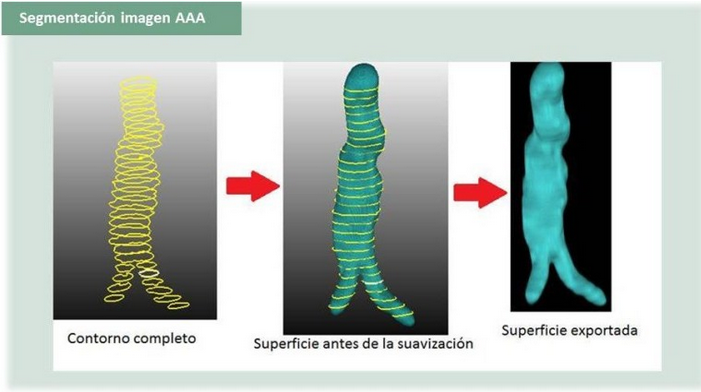The Abdominal Aorta Aneurysm (AAA) has been recognized as a major health problem in the last decade. The statistics associated with this condition are of great concern and, as recorded in most of the studies found in scientific literature, it is expected that its impact will increase in the next years mainly due to the increase in life expectancy of the population. The rupture of abdominal aortic aneurysms represents a major clinical event because of its high mortality rate.
According to Dr. Felix Nieto comments in his previous post, currently the indicators used to determine the treatment of patients with aneurysms are the maximum transverse diameter and the growth rate that can be considered insufficient; they do not have a physically grounded theoretical basis. Because of this limitation, in recent years research has been basically aimed at improving understanding of the phenomena associated with the emergence and evolution of this disease, in order to determine whether other variables could be predictive of rupture.
One of the major constraints in obtaining accurate results in modeling vascular diseases is the use of a realistic computational domain, which is closer to be possible due to technological advances in equipment for conducting tomography computed axial (CT), magnetic resonance imaging (MRI) and the development of CAD techniques, which has advanced significantly in the detailed extraction, in vivo, of anatomical structures.
CARTIF team is working on automated conversion of 2D set of images obtained by CT in a realistic 3D model that constitutes the geometric domain of integration into the AAA simulation by finite element techniques

The activity related to medical imaging AAA has been the key to one of the issues recently treated in CARTIF, called the study of the influence of geometric parameters on the rate of rupture of AAA, the work is particularly focused on iliac angle.
In the first phase they were carried out fluid dynamics and structural simulations to calculate the Rupture Potential Index (IPR) of several cases of patients affected by AAA
The results show that the values of the iliac angle (α) are related to other geometric parameters such as the eccentricity of AAA, which together can characterize the IPR.
The next step would confirm this trend over a larger database of patients with AAA, being essential as now, the good cooperation with HCUV (University Clinical Hospital of Valladolid).
For the simplicity of obtaining these parameters by the specialist through the TAC, the results of this research could be a very effective tool for the surgeon when making the decision to submit or not the patient to a surgical repair procedure.
- How to improve your processing plant without large investments? - 27 December 2017
- Fighting with triple A (AAA), the silent enemy - 23 September 2016
